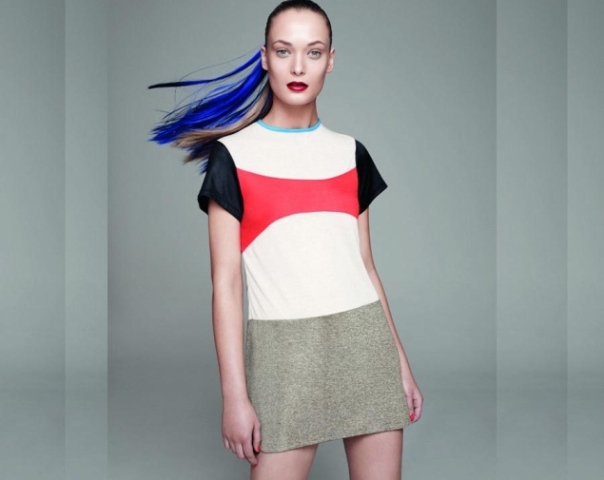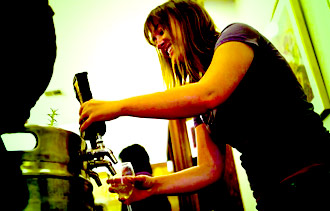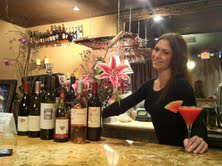Monthly Archives: May 2012
Beauty goes au naturale
Who doesn’t like the freshness of teal eyes, pink luscious lips, peach cheeks and a glowing complexion?
As the beauty industry takes a step forward, there is an equal number of men and women going back to basics.
Going organic seems to be the new mantra, what with organic soaps, creams, lotions, shampoos, lip balms and other beauty products taking a haute new avatar.
Ahalya Matthan, of Ally Matthan brand of natural fragrance and fragrance-based natural and handmade products for skin, hair, bath and personal care and Areev, a nationally available bath care range explores wellness with a holistic approach.
Natural beauty
Natural skin care is really a way of life. Plant oils, shea and cocoa butters make fantastic moisturisers, aloe and chamomile are soothing and minerals work magic to get rid of makeup lines for sensitive skin.
Look for some easy-to-find organic ingredients like rosemary, almond, wheatgerm, honey and milk in your beauty range.
Chemical free
More and more people are learning about the potential skin and hair problems associated with preservatives and other suspect chemicals in cosmetics.
Chemical-based products can give you instant results, but can damage your sensitive skin and hair in the long run.
It’s a myth that synthetic skin products work marvels as they contain chemicals that are not harmful in tiny dosages, but years of accumulated usage results in damage that you cannot see.
The skin absorbs nutrients and has the ability to heal itself, so it is a logical choice to choose whether you put a chemical or a natural product on your skin.
Go organic
If you are looking to lead a healthy life in the long run, choosing a natural or organic product is imperative.
By choosing an organic or a natural product, you are using ingredients that work with the natural systems of your skin. Here’s a know how on how to go au naturale:
Organic skin care implies that the products are made of ingredients derived directly from plants that have been cultivated without the use any chemical pesticides or fertilisers and contain no synthetic preservatives or additives.
Organic products are certified such that the end consumer can trace the origin of the farm where the ingredients were cultivated.
True organic products are hard to find as the low yield of plants cultivated without fertilizers makes them commercially unviable.
On the other hand a natural skincare product simply means that the ingredients are plant derived, cultivated with or without chemical interference, or they could alternatively mean that the ingredients are molecular clones of plant derivates.
Both products deliver the promise of the best natural ingredients for specific skincare.
Article excerpted from www.deccanchronicle.com
Topshop going green with eco capsule line; Aims to encourage sustainability within the fashion industry
Following hot on the heels of H&M’s sustainable Glamour Conscious Collection, high street retailer Topshop has teamed up with eco fashion brand Reclaim To Wear to create a debut upcycled capsule collection made entirely from discarded materials.
Materials including surplus stock and production off-cuts have gone into the line, which comprises on-trend pieces including ombre bleached denim shorts and color block panel mini and maxi dresses.
On sale from June 8 at the retailer’s London Oxford Circus store and online, the line aims to encourage sustainability within the fashion industry.
Aiming to solve the problem of textile waste, Reclaim To Wear was founded in 1997. The brand’s creative director Orsola de Castro and managing director Filippo Ricci shared their knowledge with Topshop when collaborating on the line.
“This is the first step towards the creation of zero waste design collections. I trust that the Topshop team’s commitment to new sustainable solutions will lead to the reconsidering of consumption versus disposal throughout the whole fashion industry supply chain,” said de Castro.
The new eco friendly Topshop line follows a general shift in the fashion industry towards upcycling and sustainable fashion. On the high street H&M launched its Glamour Conscious Collection back in March, comprising pieces made using sustainable materials including organic cotton, hemp and recycled polyester.
Big name designers have also been getting in on the act, with a host of labels including Valentino and Lanvin signing up to film producer Livia Firth’s Green Carpet Challenge initiative ahead of the awards ceremony season earlier this year.
Highlights on the Oscars red carpet included best actress winner Meryl Streep’s gold draped Lanvin dress made out of eco-certified sourced fabric and Firth’s red Valentino gown made of recycled polyester sourced from plastic bottles.
Article excerpted from www.nydailynews.com
A new eco-conscious expo in South Korea
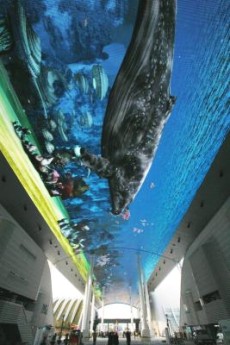
At the Expo Digital Gallery, you can watch the advanced IT and LED lighting art interwoven to create an outdoor marine culture art gallery. That amazing overhead LED screen measures 218m by 30m. — Photos by MAJORIE CHIEW/The Star and courtesy of Expo Yeosu Korea 2012
THE exhibition halls are fully booked and impossible to get into, says our tour guide, Jinny Kim. And it wasn’t even opening day at the International Exposition Yeosu Korea 2012!
Our group, though, has special permission to enter, as we are there to report on this extraordinary expo. Even before we get in, though, we hear details that are jaw-dropping: The expo, which began on Saturday and runs until Aug 12, will draw 10 million visitors, and its expected economic effect will be 12.2 trillion Korean won (RM32.7bil) as well as the creation of 80,000 new jobs, explains Yeseul Oh, a spokesperson for the expo’s organising committee.
To draw all those visitors, the 93-day expo will be jam-packed with over 3,000 cultural programmes, with 40 performances and events daily!
The venue is Yeosu’s 2.71sq km New Port development where the expo site covers an area of 250,000sqm. The result of four years of work and US$10bil (RM31bil) in investment, Expo Yeosu is the country’s second international fair since Expo Taejon (Daejeon) in 1993.
While that event was about development, this year’s theme is “The Living Ocean and Coast” and emphasises the importance of the marine environment. To quote the expo’s website, the event “will provide an opportunity to enhance the international community’s perception of the function and value of the ocean and coast, share knowledge on the proper use of the ocean and coast, and recognise the need for cooperation in the marine sector.”
In keeping with that very green spirit, the entire expo site was constructed using environmentally-friendly methods and recycled materials to produce the least amount of waste possible. All preparations and events are designed to leave a limited carbon footprint.
Basically, the expo forms a model city exhibiting the low-carbon lifestyle of the future. It is an open-air gallery housing artworks of architectural grandeur and providing a glimpse of a high-tech city circa 2050 against the backdrop of the sea.
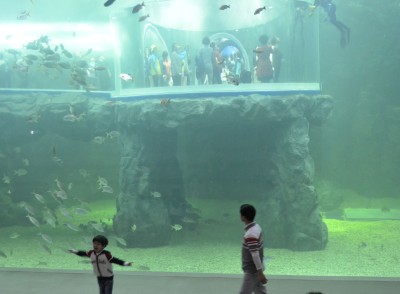
The Aquarium is well worth visiting as it is the largest in Korea and offers an up close look at rare marine species such as beluga whales.
The construction and operation of the expo facilities and exhibitions are based on South Korea’s cutting-edge information technology allowing for novel experiences involving virtual and augmented reality.
The major exhibition facilities are the Theme Pavilion, the Korea Pavilion, and the International Pavilion, which comprise a joint pavilion hosting 56 developing countries and the individual pavilions of 49 countries.
Among the areas our tour takes in on the expo’s second pre-opening day are the Aquarium and Japan Pavilion. (Our guide informs us that the Malaysian Pavilion would be worthy of a visit but that it is, unfortunately, not ready at this time.)
Just getting to the International Pavilions is fascinating because a supersized LED screen with fantastic digital shows stretches over the walkway; the 218m long by 30m wide screen is part of the Expo Digital Gallery, which is a pedestrian mall offering a variety of electronic art.
After that experience, we head to the Japan Pavilion where we are treated to footage of the beautiful seas around that country and receive sobering information about the sea’s connection with forests, cities and the March 2011 tsunami disaster. There is also a screening of an animated story about a Japanese boy, Kai, a tsunami survivor who rides a magical flying bicycle to see residents restoring their hometowns.
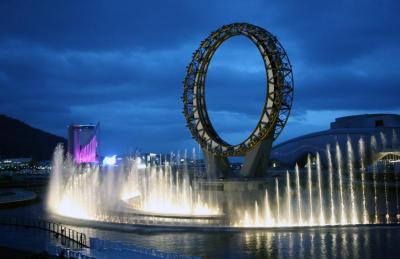
Dazzling: The night-time musical fountain show at the Big-O, one of the iconic structures at the International Exposition Yeosu Korea 2012.
Visitors are also introduced to Japan’s advanced ocean technology that help people enjoy the bounties of the sea.
If you can’t make it to every facility at the expo, do be sure to get to the Aqua Planet Aquarium – it is definitely worth a visit. It is the largest in South Korea – comprising a 6-tonne water tank – and displays 280 species of fish and rare marine species such as beluga whales from Russia. It’s awesome when you walk through a transparent tunnel and find marine life teeming around you – makes you wonder just who is in the tank!
This facility has three zones: The Coastal Life zone allows visitors to see rare ocean animals such as white whales, Baikal seals and sea dragons; the Marine Life zone can be viewed in all directions, the first of its kind in South Korea; the Eco-Terrarium zone recreates the ecological system of the Amazon and houses rare South American freshwater fish such as the pirarucu and piranha.
While we can’t get to it, we hear that the Climate & Environmental Pavilion is a hit with visitors too, as they get to experience the extreme cold of the Arctic ice-edge in the Arctic Glacier Experience section.
A myriad of futuristic robots await visitors at the DSME (Daewoo Shipbuilding and Marine Engineering) Marine Robot Pavilion. Meet Navi, the tallest robot ever introduced in South Korea. An adult comes up just knee-high to the 6.5m tall, 1 tonne machine.
Led by Navi, a fleet of robots present the performance of marine resource exploration and mineral mining in a 6,000m-deep virtual underwater environment.
There is also Ever, a feminine robot that has 30 different facial expressions, and Mero, which dances to famous songs by Korean boy band Super Junior. Also, a seven-colour robot fish and robots from other countries such as the United States, Britain and France, join a total of 73 robots on display.
The Sky Tower, the tallest structure at the expo, is a monumental piece of art, recycled and redesigned from a pair of abandoned 55m-high cement silos. It has a harp-shaped exterior, an embodiment of giant waves, but really, the tower is a fully functioning pipe organ that plays tunes related to the sea!
The Ocean Experience Park is part of the city’s concrete shore-protection project that has been turned into an eco-friendly park. It is a great venue to learn about the significance of coastal ecosystems while lapping up the pristine beauty of the sea.
And at Energy Park, you can have hands-on experience with the latest technologies using renewable energy sources such as wind and tides. This eco-friendly park also offers a place to rest while exploring these green technologies.
Apart from the different pavilions and other facilities, the expo also offers large scale events such as the state-of-the-art Night Multi-Media Show of a dazzling display of laser lights. The Big Ocean Show is a weekly performance that uses the sea, beach and ships to create different performances that reflect the expo’s theme. And the World Ocean Performance features artists on a floating stage, thus using the sea as a platform for cultural activities.
Celebrities gracing the Big-O shows include nine-time Grammy Award winner John Legend and a host of K-pop stars such as the Wondergirls, Dynamic Duo & Simon D, Beast, Jay Park, Apink, BTOB, Busker Busker, Leessang & JeongIn, 2AM, B1A4, 2PM, MissA, Infinite, Shinee, Super Junior, CNBLUE, MBLAQ, Ailee, FTIsland, and ZE:A & c.
And if you are separated from your travel companions amidst the throngs of people and carnival atmosphere at the expo, the Big-O is the place to converge. This 48m-tall round steel structure is the iconic centrepiece of what is truly an amazing expo.
For more information about the International Exposition Yeosu Korea 2012, go to eng.expo2012.kr.
The writer was part of a eight-member delegation comprising representatives of the Malaysian media, Korean Air and Korea Tourism Organisation that toured the expo before it opened. The trip was organised by the Korea Tourism Organisation and supported by Korean Air.
Article excerpted from www.thestar.com.my
Does eating organic food make you a jerk?
A new study finds that going organic can make you feel smug about yourself — and act nasty to others

Those who insist on organic artichokes might be more judgmental than shoppers who are content with conventional products. Photo: CC BY: SummerTomato
Buying and eating organic food makes many people feel better about themselves. (Not coincidentally, organic products often have panderingly positive names, such as Honest Tea, Purity Life, and Smart Balance.) The flip side, according to a new study published in Social Psychological and Personality Science, is that organic eaters often look down on others, and aren’t shy about expressing their derision. Does going organic turn you into a jerk? Here’s what you should know:
How did researchers study the effects of organic food?
They divided 60 people into three groups: One was shown images of organics, such as spinach and apples; one was shown only comfort food, such as brownies; the third reviewed pictures of basics like rice and oatmeal. Then all three groups were asked to read vignettes about moral transgressions, such as cousins having sex or an ambulance-chasing lawyer hunting clients in an ER, and rank how bad the vignettes’ protagonists were on a seven-point scale. The participants were also asked how much time they would be willing to volunteer for a fictitious study.
And what did they find?
The crowd exposed to organic foods judged others more harshly. On average, they put the offenses described in the vignettes at 5.5 on the seven-point scale. The people exposed to pictures of comfort food were the most mellow, with average ratings of 4.89. The organic group was also stingier with their volunteering time, offering to help out for 13 minutes, compared to 19 minutes for rice-and-oatmeal group, and 24 minutes for the comfort food crowd.
How do experts explain these results?
Author Kendall Eskine, a psychology professor at Loyola University in New Orleans, chalks it up to something he calls “moral licensing.” People do something they see as a good deed, so they start feeling self-righteous. They also feel like “they have permission, or license, to act unethically later on,” Eskine says. “It’s like when you go to the gym and run a few miles and you feel good about yourself, so you eat a candy bar.” How comforting, says Doug Berry at Jezebel. “Moral of the story: Eating cookies makes you a better person.”
Article excerpted from www.theweek.com
Eco-friendly art that explores the dichotomy of human nature
Arts have traditionally not been big on environment, but Iram Wani and Aleem Dad Khan take pride in their techniques being eco-friendly. Their choice of symbols — fetus for Wani and Yin Yang for Khan — serve to shift the viewer’s focus heavily on their techniques.
But this is not to say that their techniques are similar. They could hardly be more different from each other. While Wani’s approach is more sensitive and theme based, Khan’s is more technically inclined and experimental.
Wani explores the duality of the conditioned and unconditioned self and exalts the primal and overpowering part of human nature that socialisation tries to curb. “The fetus, for me, is the symbol of our most unconditioned self,” said Wani. She added that she believes all great art is an exploration and expression of the unconditioned self.
Her work use techniques such as linocut and chine-colle heavily which add a quality of cleanliness and focus to her work.
Khan, in contrast, borrows more from reductive and collagraphy techniques that are more experimental and overlapping. Ironically Khan uses the symbol of balance, Yin Yang, in a somewhat chaotic way — separating the two components of the symbol in some paintings while joining them together in unexpected permutations in others.
Referring to his painting “Yin Yang Bang”, Khan said, “I’m trying to show the balance and imbalance in the universe, the organised chaos that is responsible for our evolution.”
The two artists do also try to look to other sources for their paintings. Wani showcases a scene of urban life with buildings in her piece “Contrived”.
“This is a depiction of the conditioned life we all lead, it is not natural but man-made, hence the title,” said Wani.
Similarly Khan too has used the image of buildings in his “A depiction of the city Swansea in Wales”. He shares it is a collaborative piece with his teacher Sara Hopkins.
Both artists have shown their work in numerous exhibits and have done their Bachelors of Fine Arts from the National College of Arts, Lahore. The exhibition will continue at the Nomad Gallery till May 31.
Published in The Express Tribune, May 19th, 2012.
Article excerpted from www.tribune.com.pk
Vegan Dogs (and homemade dog food!)
Anytime someone meets my dogs (and they’re aware I’m vegan) they ask if my dogs are vegan too. I would have thought the answer would be an obvious “yes” but most often, people seem surprised when I tell them, “yup, the whole family is veg!”
I get the question via email too, so I thought I’d put it out there that yes, my dogs are vegan and they are thriving.
If you’re wondering if dogs can be vegan, the answer is yes. Dogs, like humans, don’t need meat to survive. The pugs’ vets in Boston, Los Angeles and New York City have all been supportive of their vegan diet and one even said she would recommend a vegan diet over an omnivorous one if she thought more dog owners would be open to the idea.
Although there are several brands of vegan kibble on the market (Nature’s Balance, V-dog, Wenaewe, Pet Guard, Avo Derm, Natural Life, Evolution Diet and Wysong) I prefer to make vegan dog food myself.
It all started a month ago when we ran out of vegan kibble at home, and to make matters worse, the store was sold out, too. Obviously the pugs couldn’t go hungry so I made them a plate of rice and beans. The next morning I made them a plate of peas and apples and that night, peas and beans. It continued on for days and by the time the store had called to say they had our kibble, I didn’t bother to go buy it.
Of course, Scott was skeptical. He wondered how long I’d last at making fresh meals for our dogs every day, twice a day — but a month later I’m still doing it!
I’ve noticed a dramatic shift in the pugs since we started on home cooked meals. Although they liked their vegan kibble, they were never excited about meal time. Really, they could take it or leave it. Now they bark and do circles — they couldn’t be more thrilled to eat their supper.
I’ve also noticed a change in their…bodily functions. The pugs were never constipated or anything, but we always had to walk them around the block a few times before they were ready to do their business. Now, they poop much quicker and with more ease. I’m convinced it’s all the added fiber. There is little to no fiber in kibble, so it’s not surprising they’re going much more easily now.
I’ve also noticed a change in their urine. Quaid and LilyBean used to have deep yellow pee, which always made me worry they could be dehydrated. Now their urine is much, much lighter in color. I’m convinced its because they’re getting water from their food now. Water is in the rice they eat and the beans I cook for them– vs. kibble which is dehydrated.
By now you’re probably thinking “This sounds great, but I don’t have the time to cook two meals for myself, let alone my dog!” But I promise, you do — and it will save you money! I’m spending a fraction of what I used to on kibble!
Here’s how I do it: I cook an entire bag of brown rice once a week, storing leftovers in my fridge. I do the same with a bag of beans and I’ll steam or bake sweet potatoes while I’m add it. Every day I’ll put brown rice, beans and either a sweet potato or thawed frozen peas into their bowl. It takes seconds.
I’ve also recently started added chopped fresh apples and zucchini from my garden. I also keep a bag of puffed brown rice on hand, and a few cans of beans, just in case I run out.
When I started making my own dog food, I was skeptical I’d have the time or energy to keep up with it — but it hasn’t been a problem at all and now it’s a habit. I’ll put rice and beans on the stove when I’m watching a movie, cleaning the apartment or doing something else. An hour later I have all their food done for the week and I’ve been known to swipe some for myself, too.
I’ve also realized that I can thaw frozen peas under hot water in less than 20 seconds when I’m really desperate. (They really love peas!)
I can’t recommend making homemade vegan dog food enough. The pugs seem to like every bean, vegetable and fruit I throw at them, but they’re particularly fond of: corn, peas, sweet potatoes, black beans, kidney beans, black soy beans, tempeh, apples, bananas, carrots, cucumbers, zucchini, asparagus, brown rice (they actually won’t eat white rice), collard greens, kale, spinach, whole grain cereal and oatmeal.
Just be sure to avoid giving your dogs raisins, grapes, garlic, onions or mushrooms.
Perhaps my pugs are the luckiest dogs in the world, at least in terms of their food (they’re still envious of dogs with big backyards!) but hopefully with this post I’ll convince a few more dog owners to nurture their pets with natural, plant-based foods!
Update: we now live abroad where I have no choice but to feed the dogs home cooked meals. I start with a protein base — beans or lentils, and then mix in leftover raw vegetables (chopped well), pumpkin (for Lily Bean’s eyes) and any leftovers or leftover grains I have, like brown rice. We joke that the dogs are our compost bin. I always make sure to give them a mix and variety — right now their food is a base of lentils, with bell pepper, cucumber, yellow squash, cabbage, lettuce and cauliflower, plus some leftover rice.
Supplemant: I use veg-e-dog supplement as a proactive measure. The company sends great dog food recipes with their vitamins which I love!
Article excerpted from www.happyherbivore.com

